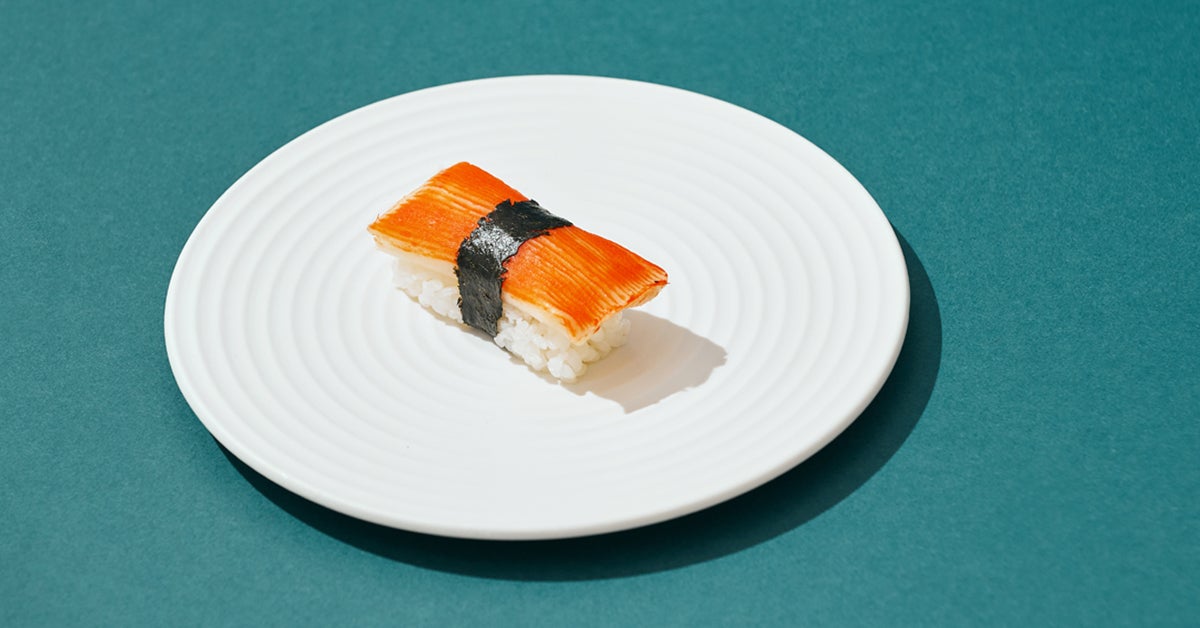
You likely have many questions when you become pregnant, and whether you can and should eat seafood is a common one.
The answer? It depends.
On one hand, grilled and broiled seafood are good sources of lean protein that also happen to be packed with brain-boosting omega-3 fatty acids.
On the other hand, your stuffed filet of sole could be filled with more than just breading. In fact, it might be rife with mercury, parasites, and pollutants. (Would you like soup or salad with that? Or have you completely lost your appetite?!)
Knowing that, no one could blame you for choosing imitation crab the next time you’re standing at the deli counter weighing your options. It’s the best of both worlds, right? You get the benefits of seafood without all the toxins?
Or do you? Here’s the dish on eating imitation crab while pregnant, from what it actually is to when it’s safe to eat.
Let’s get this straight right away: Imitation crab isn’t really crab. Like, not even a little. It’s a mashup of fish paste, seasonings, starch, egg whites, and crab flavoring. Pollock is usually the type of fish minced up and turned into the fish paste, which is called surimi, used to make imitation crab meat.
There are two questions you have to ask about every type of seafood during pregnancy: Is it a low mercury food, and has it been cooked? Imitation crab meat checks both boxes, so it’s safe to eat during pregnancy.
Pollock, which is the fish of choice for makers of imitation crab meat, is a low mercury fish and pregnancy-safe in reasonable amounts (two or three servings per week).
So are many other types of fish, though some that should be avoided if they’ve been added to your crab meat — namely shark, swordfish, king mackerel, and a few others.
However, no seafood should be eaten raw during pregnancy.
Even though your imitation crab meat is cooked, if it has been used in a seafood dish (like sushi or stuffed lobster), you need to make sure everything has been fully cooked before you consume it. So that California roll with imitation crab inside but topped with raw tuna? It’s a no-go.
If you consume raw fish or meat, you run the risk of ingesting bacteria (or parasites) that could make you super sick. (During pregnancy, you have a weaker immune system.)
Honestly, imitation crab meat isn’t really doing you any nutritional favors. And real crab meat is actually considered a beneficial seafood when you’re expecting, as it’s low in calories but high in omega-3s and vitamins D and A.
But again, the imitation stuff is — well, an imitation. You’re not reaping those benefits here. You are, however, eating a food item that is:
- low in calories and fat
- low in mercury
- affordable and convenient
- always precooked and pasteurized (i.e., safe to eat)
As long as any dish containing imitation crab meat has been properly stored and cooked, there’s no real danger in eating it. That said, better choices are out there. (Some people compare eating imitation crab meat to eating hot dogs in terms of processing — and we basically agree.)
Below are some drawbacks of eating imitation crab while pregnant:
- While regular crab meat is a source of protein, imitation crab meat isn’t.
- Sodium is usually added to imitation crab meat — and you can’t control how much, as it’s prepackaged.
- It typically contains random ingredients that don’t provide any nutritional benefit. Rather, they just flavor and color the meat, preserve it, and improve its texture. This means everything from artificial dyes and sweeteners to xanthan gum and sometimes even monosodium glutamate (MSG).
Keep in mind that unless you’re eating imitation crab meat right out of the package (umm… yuck?), you’ll need to be mindful of what else you’re consuming as part of the dish.
For example, if you’re chowing down on sushi, you need to be super aware of what other ingredients are included and whether they’ve been fully cooked.
And just because the imitation crab itself is fully cooked doesn’t mean it’s shelf-stable. It should always be kept chilled or in the refrigerator (don’t leave it sitting out for more than 1 to 2 hours).
Also, once a package has been opened, it should be consumed within 3 days. If it smells or looks “off” in any way, toss it — we promise, the risk of food poisoning when you’re pregnant isn’t worth it.
Lastly, if you’re dining out, don’t feel shy about asking the server or chef what the imitation crab was made with. Again, it’s usually pollock, but it’s a good idea to double-check that it wasn’t made with any high mercury ingredients.
When given a choice, opt for real crab. It’s not only safe to consume but also low in calories, high in omega-3s, and full of vitamins (i.e., it’s pretty darn good for you!). The same can’t be said for imitation crab meat, which doesn’t contain any actual crab.
That said, if you don’t have a choice or just prefer imitation crab, there’s nothing wrong with eating it. It’s perfectly safe as long as it’s stored correctly, made with low mercury fish, and all other ingredients in the dish are fully cooked.
Can I Eat Imitation Crab While Pregnant? - Healthline
Read More

No comments:
Post a Comment